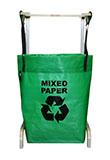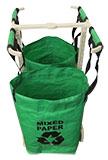Very little of what is thrown away on campus actually belongs in the garbage. The MiniMax program has been adopted by the University of Washington to make waste sorting easier for building occupants, reduce landfill waste, and allow custodial staff to spend more time on essential cleaning tasks. UW Recycling staff work with building coordinators, occupants and custodial staff to ensure that containers are accessible and consistent.
Offices and workstations
Individual offices and workstations have self-service “MiniMax” containers. These containers consist of a 3-quart black garbage bin attached to a 28-quart green recycling bin. Staff are responsible for emptying their bins into the centrally-located recycling, landfill or compost containers. This helps promote personal responsibility for waste generation.
Shared workstations
Shared desks do not typically get a MiniMax bin. This is because there is not a designated person emptying the desk-side bin and keeping it clean. It’s common for people to decline MiniMax bins. They dispose of their waste in the larger waste bins located nearby.

Public areas
Garbage, recycling and compost bins are available in public areas across campus.
- Centralized container sets offer convenient access for building occupants and patrons.
- All public area garbage bins coordinate with at least one recycling bin. Compost bins are included as needed for kitchens, breakrooms or hallways.
- Signs and labels clearly indicate what items should be placed in each container.
Restrooms
Paper towels are collected for compost instead of going to the landfill. Wall-mounted or standing compost collection containers are labeled “paper towels only”. Each restroom has a 28-quart black waste bin labeled “trash” for non-compostable waste.
Classrooms, teaching and computer labs
Garbage, recycling and compost bins are located near classrooms, rather than in them. This helps increase waste diversion and cleaning efficiency.
Research labs and patient care areas
The MiniMax program does not affect waste containers or service in research labs or medical patient care rooms.
Mailing or printing
In some offices, labs or shared spaces on campus, recyclable office paper is collected in Bagits — reusable bags on stands.
Custodial Services empties full Bagits as part of their routine cleaning services. Bagits are not permitted in individual offices or hallways, according to Environmental Health & Safety policy and Seattle Fire Department regulations. Bagits have a 35 lb. weight limit.

Single Bagit Station (currently not in stock)

Double Bagit Station